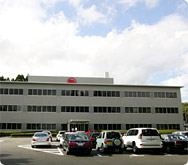| With podium finishes and other exciting results, the Panasonic Toyota Racing
Team was able to finish the 2005 season with positive momentum going into next.
And behind it all was the support of the engineers laboring tirelessly at the
Toyota Motor Corporation research facilities. To date, only a handful of media
stories have even mentioned the work of these scientists, since so much of it
is conducted behind the scenes. If TMG is able to work successfully in the center-stage
spotlight of the F1 circuit, it is because the Japanese engineers involved in
advanced development back at Toyota’s research facilities have carefully
laid the groundwork.
Here, we will be introducing the Toyota F1 organization, providing an informative
overview of the advanced development group.
|
Toyota Motor Corporation is a Japanese auto manufacturer headquartered in
Japan. The company produces and sells more than seven million cars annually (as
of March 2005), with two-thirds of the cars sold outside the Japanese market.
The company maintains production centers throughout the world, including Europe
and North America.
With Europe as one main stage of activity for Toyota, locating the front-line
base of F1 operations in Europe has been extremely significant. Meanwhile, advanced
development for the F1 program is conducted in Japan, which continues to serve
as the core of advanced development utilizing specialized facilities and staff
supporting the worldwide expansion of Toyota automobiles. In fact, advanced development
for both production cars and F1 cars are conducted within the same facilities.
The Toyota Motor Corporation Higashi-Fuji Technical Center
Located
in the foothills of Mt. Fuji, Japan’s highest peak, the Higashi-Fuji Technical
Center conducts advanced research and development related to Toyota Motor Corporation
production vehicles. The vast facilities, sprawling across more than 6.6 million
square meters, boast a 4-kilometer track and laboratories housing the latest
in technical equipment. Occupying one corner of the research laboratories is
the Motor Sports Division, responsible for conducting advanced research for the
F1 program.
 |
 |
The Higashi-Fuji Technical Center is home to a variety of research projects aimed at bringing a brighter future to the world's citizens. Projects include body and chassis technical development influencing production car drivability, stability and comfort; power-train research and development linked to better fuel efficiency and lower pollution, research related to environmental and energy issues, and much more. Advanced F1 development conducted by the Motor Sports Division is just one more example of ongoing projects at the Center.
Specific Motor Sports Division F1 Activities
The TMG group focuses their time and attention on the race at hand. Meanwhile,
the Motor Sports Division conducts advanced development based on a long-range
vision, allowing TMG the freedom to concentrate on racing. For example, during
the 2005 season, while TMG endeavored to shave one second off the following day’s
lap time, the Motor Sports Division was conducting advanced development related
to the 2.4 liter/V8 engine that will be used during the 2006 season.
As the spotlight has been focused on aerodynamics as an important factor determining
the speed of an F1 car, the Higashi-Fuji Technical Center added an advanced chassis
development program as a complement to their engine development work. While exchanges
between TMG and Higashi-Fuji are basically accomplished through satellite communications
and email, both sides agree that on the philosophy that it is best to “hash
out issues face-to-face.” Accordingly, engineers from the Higashi-Fuji
Technical Center routinely travel back and forth between Japan and Germany on
short-term business trips, or on longer-term assignments as “on-loan” personnel.
Since the day Toyota launched its F1 program, Keizo Takahashi has served as the
TMG Director – Technical Coordination, and many other engineers from Japan
have also been involved in F1 activities, acting as a bridge for technology exchange
between TMG and the Higashi-Fuji Technical Center.
|